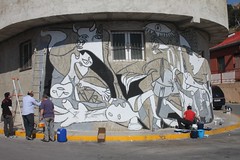Today is the 80th anniversary of the Kinder Scout Trespass, a mass action whose repercussions led to the formation of the Ramblers' Association, and the creation of the first National Park in the Peak District in 1949. We owe the 'right to roam', which we now take so much for granted, to actions like this.
There's a lovely little 'In Praise of . . . Benny Rothman' in today's Guardian - Benny, a keen rambler and cyclist, then aged 20, was the driving force and principal leader of the trespass. He died 10 years ago; you can read an obituary, or go for the full story from the Working Class Movement Library, which I highly recommend.
The Guardian's 'In praise of . . . ' piece says that Benny had "a rare combination of being able to imagine a different way of organising society and a willingness to fight for it." Not so rare, maybe - they bred them like that in the 1930s, my aunt Margaret Stanton, for example.
I went to Kinder Scout for the first time last year - on my birthday, which was nice. We walked for an couple of hours, but didn't have time - or energy - to go right up to the top; nevertheless it was wonderful just to breathe in the calm and timelessness of the hills. Thank you, Benny.


